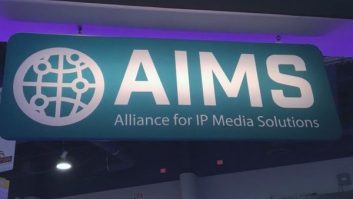 The many members of AIMS are connected by a common goal: promoting a standards-based approach to ensuring interoperability in IP-based media workflows. To that end we’ve collaborated to draw up a roadmap that outlines the standards and specifications we believe are the building blocks the broadcast and pro AV industries will use to meet modern audio, video, and data requirements in the IP realm.
The many members of AIMS are connected by a common goal: promoting a standards-based approach to ensuring interoperability in IP-based media workflows. To that end we’ve collaborated to draw up a roadmap that outlines the standards and specifications we believe are the building blocks the broadcast and pro AV industries will use to meet modern audio, video, and data requirements in the IP realm.
The SMPTE ST 2110 suite of standards for professional media over IP is a critical element in this roadmap. With the right foundation of standards, media organisations can achieve very low-latency, pristine-quality delivery chains and production capabilities, delivering the best possible video and audio to downstream processing systems and, ultimately, the media consumer.
IP takes hold
As with any transition – analogue to digital, SD to HD, tape- to file-based – the move to IP can take years, even a decade, as facilities renew their plants with long-term capex purchases. Nevertheless, we’ve seen the industry move past the early adopter phase and into mainstream implementation. While many facilities maintain and continue to work with SDI systems with no problem, much new investment appears to be shifting to IP infrastructure and equipment.
Take a look at the newest generation of OB trucks, for example, and you’ll find that they are full-IP units built on the ST 2110 standards and equipped with IP-capable cameras, routers, switchers, and so on. While they aren’t evolving at quite the same rate, fixed broadcast facilities are migrating to IP in earnest, as well. IP is being used by major broadcasters around the globe, and it has supported an increasing number of high-profile live events across sports, news, and entertainment.
The increasing popularity of IP is also evident in the number of vendors taking part in industry events. More than a year ago, 68 vendors took part in the IP Showcase at IBC 2019, demonstrating interoperability with about 170 unique products. Product development and launches have increased markedly since that time, accelerated in part by the sudden need to support remote IP-based production workflows.
The Joint Task Force for Network Media (comprising AMWA, EBU, SMPTE and VSF) formed to streamline both system installation and the configuration experience, which can be complex in a multivendor environment. Member organisations collaborated to create a new specification, JT-NM TR-1001-1, or “System Environment and Device Behaviors for SMPTE ST 2110 Media Nodes in Engineered Networks”. As media organisations continue the move to IP, JT-NM TR-1001-1 offers both specifications and guidance to simplify configuration.
IP adoption accelerates
As we move into 2020, we have seen IP adoption accelerating. While there are many benefits to IP, flexibility in handling different sources and formats gives broadcasters unprecedented agility in adapting to current and future technical requirements.
When you’re working with ST 2110, you worry far less about the next format coming down the road. Will you stay in HD at 1080I? Or go to a 3G format, like 1080P 50, or 1080P 60? Maybe you’re ready for the move to UHD, or HDR, or both? ST 2110 is designed to handle all of those formats. As a result, it’s possible to spec your core networking system for one format, knowing it will be able to support any other format in the future.
In addition to supporting future formats, IP is the on-ramp to the virtualised future. Once you get all your signals into an IP infrastructure, it’s the first step to sending them anywhere – across a room, a facility, a city, or the world. You can pool resources, establish distributed workflows, reduce real estate costs, and leverage the cloud more easily.
The industry’s shift to IP and its embrace of commercial off-the-shelf (COTS) hardware and networking have enabled an incredibly rapid rethinking and restructuring of conventional content production and distribution workflows. Robust standards and specifications – ST 2110, ST 2022, AES 67, and others – play a vital role in ensuring that audio, video, and data streams are handled in a consistent manner that supports various IP-based media workflows.
Understanding the value of IP in enabling new or extended remote production workflows, many media organisations pushed forward with innovative new solutions in order to meet high consumer demand for engaging content, and live programming in particular.
A new frontier for AIMS
While IP adoption worldwide continues, there is still work for AIMS and its partners in improving the IP experience, both with our traditional focus on media and entertainment and a new focus: pro AV. Many AIMS members serve both the broadcast and pro AV markets, and they communicated that a lack of standards- and open specifications-based media-over-IP protocols is a significant issue for the pro AV industry. Like the broadcast industry, pro AV stands to benefit from a standards- and open specifications-based approach.
For this reason, almost one year ago at ISE 2020 in Amsterdam, the AIMS Pro AV Working Group introduced Internet Protocol Media Experience (IPMX), a proposed set of open standards and specifications designed to enable carriage of compressed and uncompressed video, audio, and data over IP networks. Implementing a standards-based approach based on SMPTE ST 2110, IPMX addresses the pro AV industry’s need for a single set of common, ubiquitous standards-based protocols that ensure interoperability for AV over IP.
Pro AV is a healthy and growing industry, and IPMX gives corporations, government agencies, healthcare, and other markets the foundation they need to take advantage of audio and video over IP across their facilities and operations. Providing a framework for open, easy-to-deploy solutions, IPMX offers a future-proof approach to meeting the video, audio, and data requirements of current and future pro AV solutions over IP. Now that we’ve begun the IPMX journey, we believe it will deliver benefits that make it easier for both the Pro AV and broadcast markets to configure and maintain IP-based systems.
The future of media over IP
AIMS’ work is far from finished, and we’re always looking for additional partners to help make IP adoption easier for broadcasters and companies in the pro AV space. Anyone interested either in promoting standards- and open specifications-based IP or learning more about it is welcome to join the alliance. It’s very easy to join, and it’s a great place to work with colleagues to bring about the promise of IP for media applications.
For more information on AIMS, visit the website: www.aimsalliance.org or contact Tina Lipscomb at [email protected].






